BTEC Business Communication Report: Tesco's Communication Analysis
VerifiedAdded on 2020/07/23
|10
|2447
|98
Report
AI Summary
This report provides a comprehensive analysis of business communication, focusing on various types of communication, including verbal, written, and multimedia. It examines internal and external business information, with a specific focus on Tesco as a case study. The report delves into external communication methods, such as websites and packaging, highlighting their role in attracting customers and promoting products. It also addresses legal and ethical issues related to business information, covering the Data Protection Act, Freedom of Information Act, and Human Rights Act. Furthermore, the report explores operational issues, such as data security and backups, and discusses electronic and non-electronic methods for communicating business information, like letters, memos, and faxes. The conclusion emphasizes the importance of effective communication in business and the need for managers to adhere to relevant regulations.
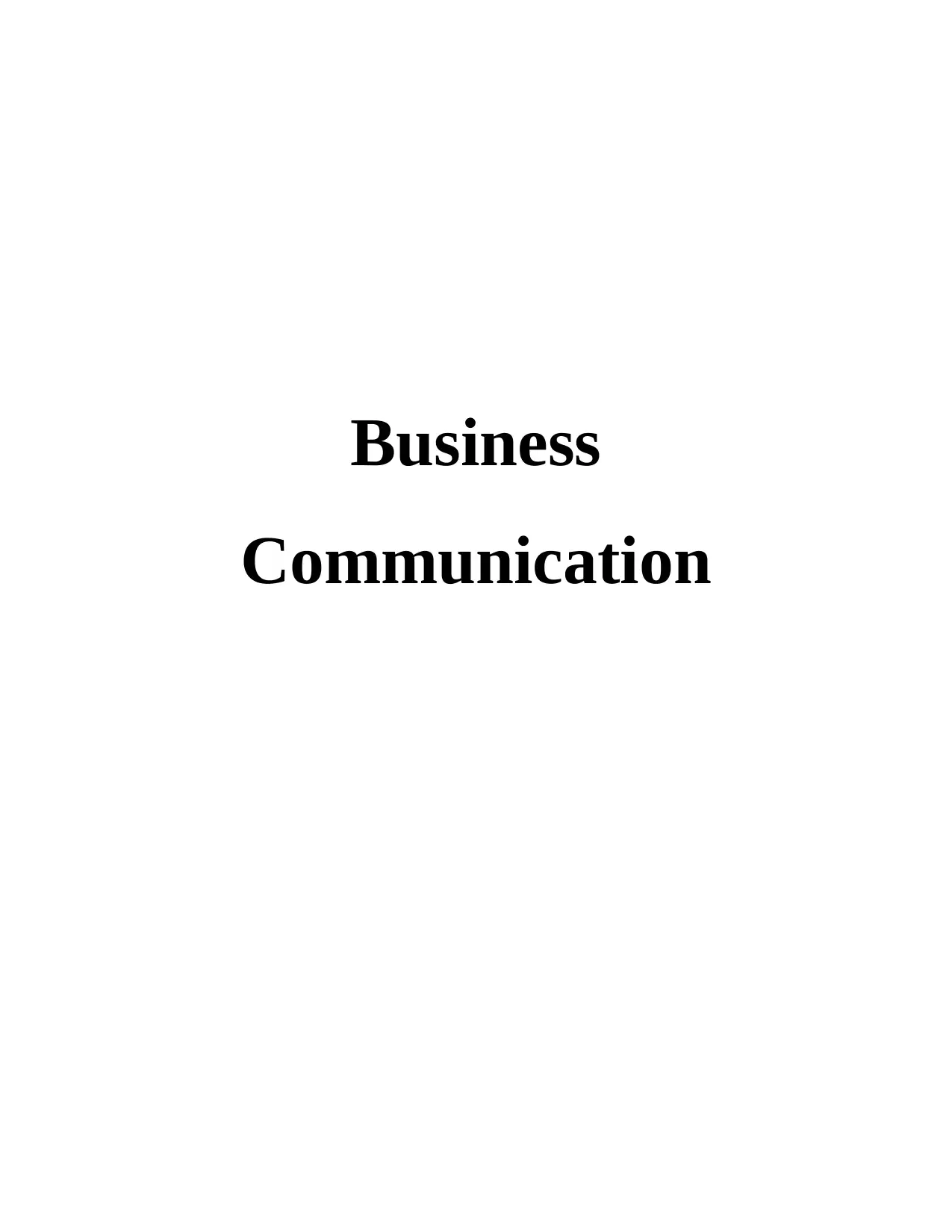
Business
Communication
Communication
Paraphrase This Document
Need a fresh take? Get an instant paraphrase of this document with our AI Paraphraser
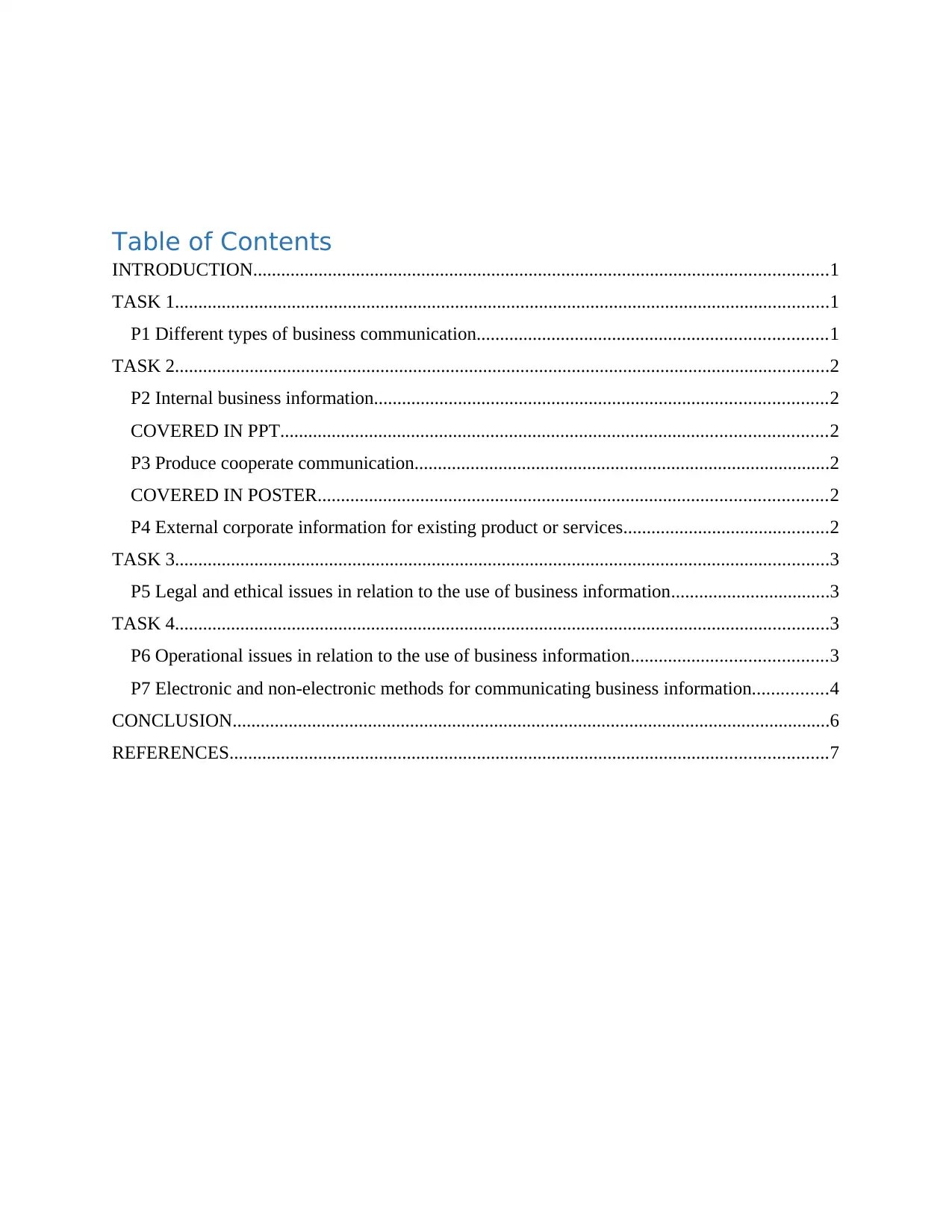
Table of Contents
INTRODUCTION...........................................................................................................................1
TASK 1............................................................................................................................................1
P1 Different types of business communication...........................................................................1
TASK 2............................................................................................................................................2
P2 Internal business information.................................................................................................2
COVERED IN PPT.....................................................................................................................2
P3 Produce cooperate communication.........................................................................................2
COVERED IN POSTER.............................................................................................................2
P4 External corporate information for existing product or services............................................2
TASK 3............................................................................................................................................3
P5 Legal and ethical issues in relation to the use of business information..................................3
TASK 4............................................................................................................................................3
P6 Operational issues in relation to the use of business information..........................................3
P7 Electronic and non-electronic methods for communicating business information................4
CONCLUSION................................................................................................................................6
REFERENCES................................................................................................................................7
INTRODUCTION...........................................................................................................................1
TASK 1............................................................................................................................................1
P1 Different types of business communication...........................................................................1
TASK 2............................................................................................................................................2
P2 Internal business information.................................................................................................2
COVERED IN PPT.....................................................................................................................2
P3 Produce cooperate communication.........................................................................................2
COVERED IN POSTER.............................................................................................................2
P4 External corporate information for existing product or services............................................2
TASK 3............................................................................................................................................3
P5 Legal and ethical issues in relation to the use of business information..................................3
TASK 4............................................................................................................................................3
P6 Operational issues in relation to the use of business information..........................................3
P7 Electronic and non-electronic methods for communicating business information................4
CONCLUSION................................................................................................................................6
REFERENCES................................................................................................................................7
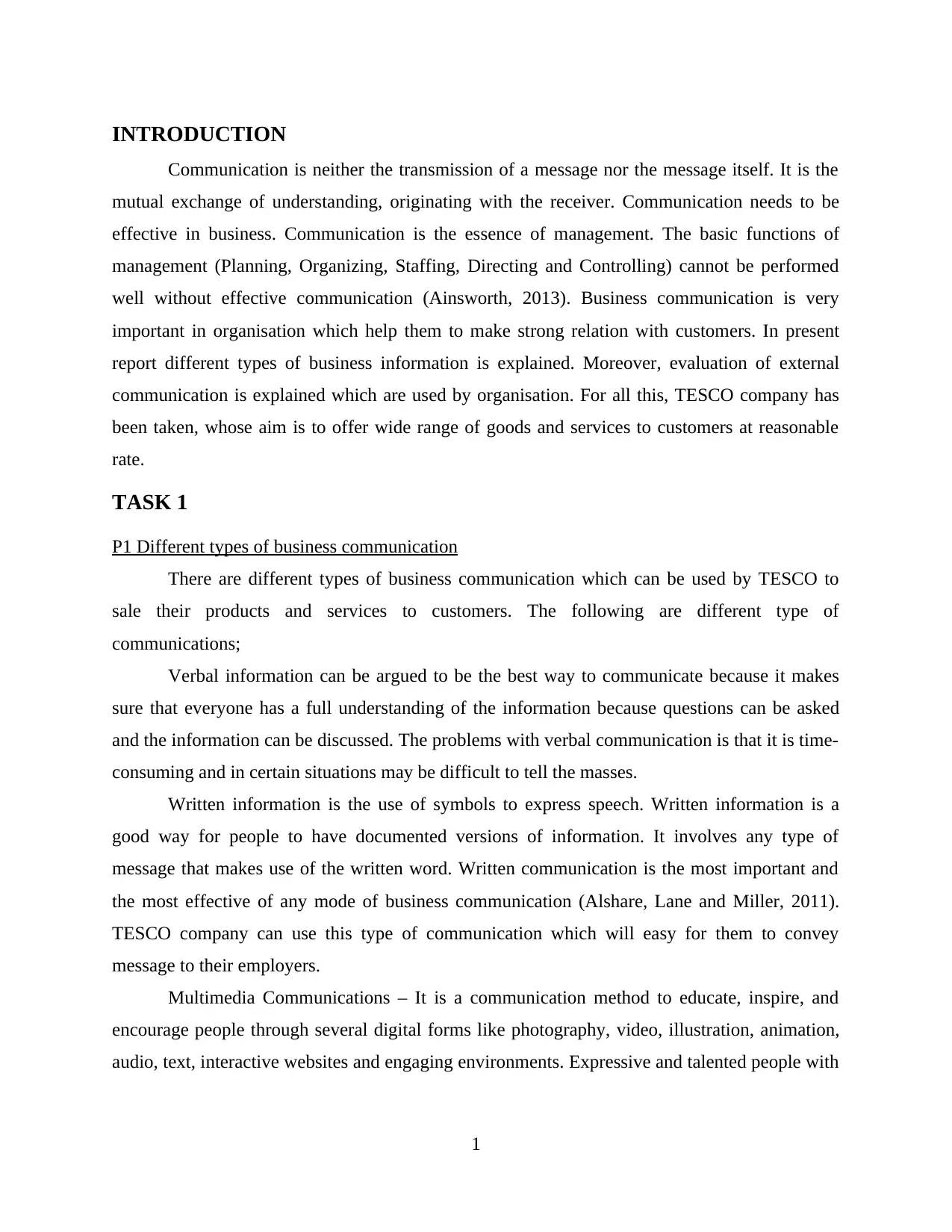
INTRODUCTION
Communication is neither the transmission of a message nor the message itself. It is the
mutual exchange of understanding, originating with the receiver. Communication needs to be
effective in business. Communication is the essence of management. The basic functions of
management (Planning, Organizing, Staffing, Directing and Controlling) cannot be performed
well without effective communication (Ainsworth, 2013). Business communication is very
important in organisation which help them to make strong relation with customers. In present
report different types of business information is explained. Moreover, evaluation of external
communication is explained which are used by organisation. For all this, TESCO company has
been taken, whose aim is to offer wide range of goods and services to customers at reasonable
rate.
TASK 1
P1 Different types of business communication
There are different types of business communication which can be used by TESCO to
sale their products and services to customers. The following are different type of
communications;
Verbal information can be argued to be the best way to communicate because it makes
sure that everyone has a full understanding of the information because questions can be asked
and the information can be discussed. The problems with verbal communication is that it is time-
consuming and in certain situations may be difficult to tell the masses.
Written information is the use of symbols to express speech. Written information is a
good way for people to have documented versions of information. It involves any type of
message that makes use of the written word. Written communication is the most important and
the most effective of any mode of business communication (Alshare, Lane and Miller, 2011).
TESCO company can use this type of communication which will easy for them to convey
message to their employers.
Multimedia Communications – It is a communication method to educate, inspire, and
encourage people through several digital forms like photography, video, illustration, animation,
audio, text, interactive websites and engaging environments. Expressive and talented people with
1
Communication is neither the transmission of a message nor the message itself. It is the
mutual exchange of understanding, originating with the receiver. Communication needs to be
effective in business. Communication is the essence of management. The basic functions of
management (Planning, Organizing, Staffing, Directing and Controlling) cannot be performed
well without effective communication (Ainsworth, 2013). Business communication is very
important in organisation which help them to make strong relation with customers. In present
report different types of business information is explained. Moreover, evaluation of external
communication is explained which are used by organisation. For all this, TESCO company has
been taken, whose aim is to offer wide range of goods and services to customers at reasonable
rate.
TASK 1
P1 Different types of business communication
There are different types of business communication which can be used by TESCO to
sale their products and services to customers. The following are different type of
communications;
Verbal information can be argued to be the best way to communicate because it makes
sure that everyone has a full understanding of the information because questions can be asked
and the information can be discussed. The problems with verbal communication is that it is time-
consuming and in certain situations may be difficult to tell the masses.
Written information is the use of symbols to express speech. Written information is a
good way for people to have documented versions of information. It involves any type of
message that makes use of the written word. Written communication is the most important and
the most effective of any mode of business communication (Alshare, Lane and Miller, 2011).
TESCO company can use this type of communication which will easy for them to convey
message to their employers.
Multimedia Communications – It is a communication method to educate, inspire, and
encourage people through several digital forms like photography, video, illustration, animation,
audio, text, interactive websites and engaging environments. Expressive and talented people with
1
⊘ This is a preview!⊘
Do you want full access?
Subscribe today to unlock all pages.

Trusted by 1+ million students worldwide
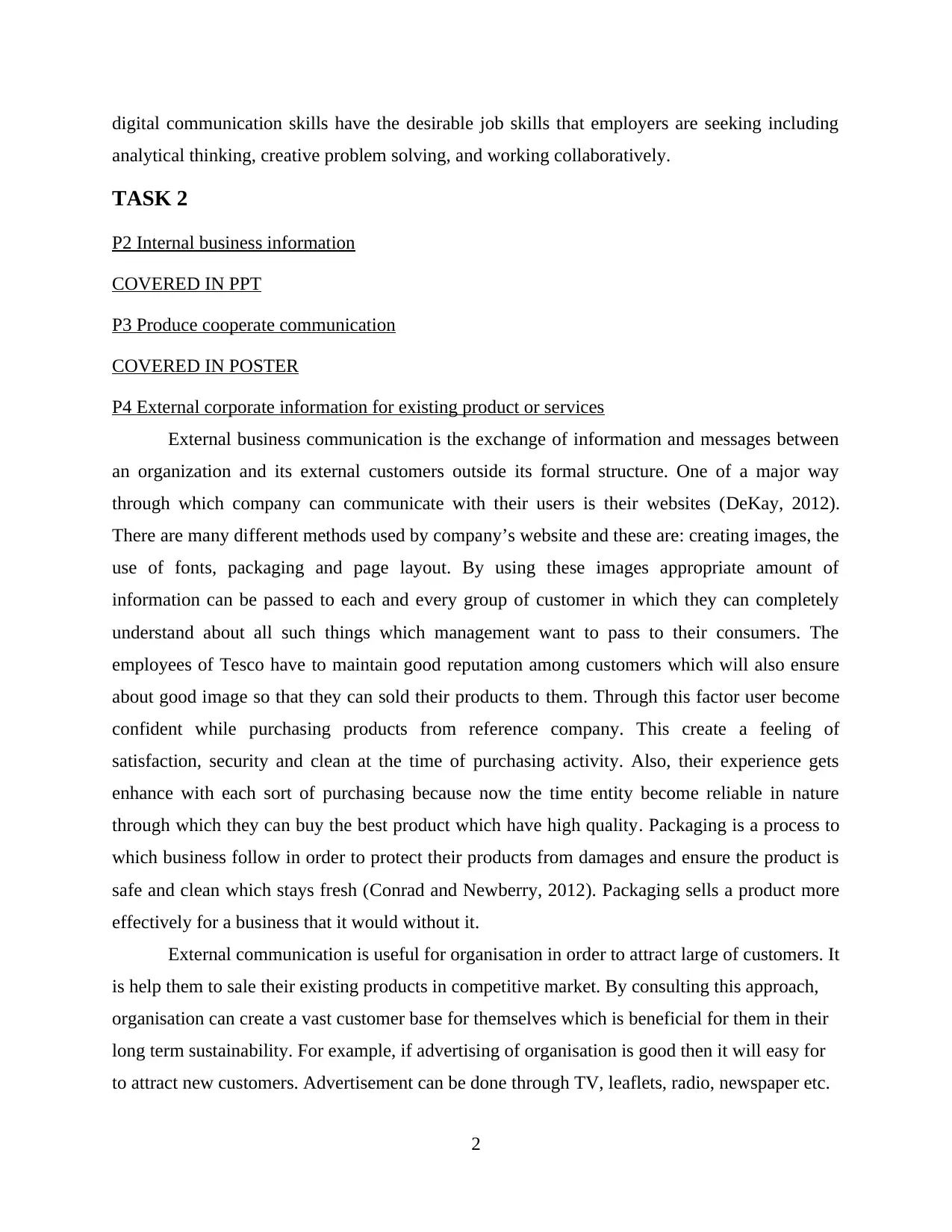
digital communication skills have the desirable job skills that employers are seeking including
analytical thinking, creative problem solving, and working collaboratively.
TASK 2
P2 Internal business information
COVERED IN PPT
P3 Produce cooperate communication
COVERED IN POSTER
P4 External corporate information for existing product or services
External business communication is the exchange of information and messages between
an organization and its external customers outside its formal structure. One of a major way
through which company can communicate with their users is their websites (DeKay, 2012).
There are many different methods used by company’s website and these are: creating images, the
use of fonts, packaging and page layout. By using these images appropriate amount of
information can be passed to each and every group of customer in which they can completely
understand about all such things which management want to pass to their consumers. The
employees of Tesco have to maintain good reputation among customers which will also ensure
about good image so that they can sold their products to them. Through this factor user become
confident while purchasing products from reference company. This create a feeling of
satisfaction, security and clean at the time of purchasing activity. Also, their experience gets
enhance with each sort of purchasing because now the time entity become reliable in nature
through which they can buy the best product which have high quality. Packaging is a process to
which business follow in order to protect their products from damages and ensure the product is
safe and clean which stays fresh (Conrad and Newberry, 2012). Packaging sells a product more
effectively for a business that it would without it.
External communication is useful for organisation in order to attract large of customers. It
is help them to sale their existing products in competitive market. By consulting this approach,
organisation can create a vast customer base for themselves which is beneficial for them in their
long term sustainability. For example, if advertising of organisation is good then it will easy for
to attract new customers. Advertisement can be done through TV, leaflets, radio, newspaper etc.
2
analytical thinking, creative problem solving, and working collaboratively.
TASK 2
P2 Internal business information
COVERED IN PPT
P3 Produce cooperate communication
COVERED IN POSTER
P4 External corporate information for existing product or services
External business communication is the exchange of information and messages between
an organization and its external customers outside its formal structure. One of a major way
through which company can communicate with their users is their websites (DeKay, 2012).
There are many different methods used by company’s website and these are: creating images, the
use of fonts, packaging and page layout. By using these images appropriate amount of
information can be passed to each and every group of customer in which they can completely
understand about all such things which management want to pass to their consumers. The
employees of Tesco have to maintain good reputation among customers which will also ensure
about good image so that they can sold their products to them. Through this factor user become
confident while purchasing products from reference company. This create a feeling of
satisfaction, security and clean at the time of purchasing activity. Also, their experience gets
enhance with each sort of purchasing because now the time entity become reliable in nature
through which they can buy the best product which have high quality. Packaging is a process to
which business follow in order to protect their products from damages and ensure the product is
safe and clean which stays fresh (Conrad and Newberry, 2012). Packaging sells a product more
effectively for a business that it would without it.
External communication is useful for organisation in order to attract large of customers. It
is help them to sale their existing products in competitive market. By consulting this approach,
organisation can create a vast customer base for themselves which is beneficial for them in their
long term sustainability. For example, if advertising of organisation is good then it will easy for
to attract new customers. Advertisement can be done through TV, leaflets, radio, newspaper etc.
2
Paraphrase This Document
Need a fresh take? Get an instant paraphrase of this document with our AI Paraphraser
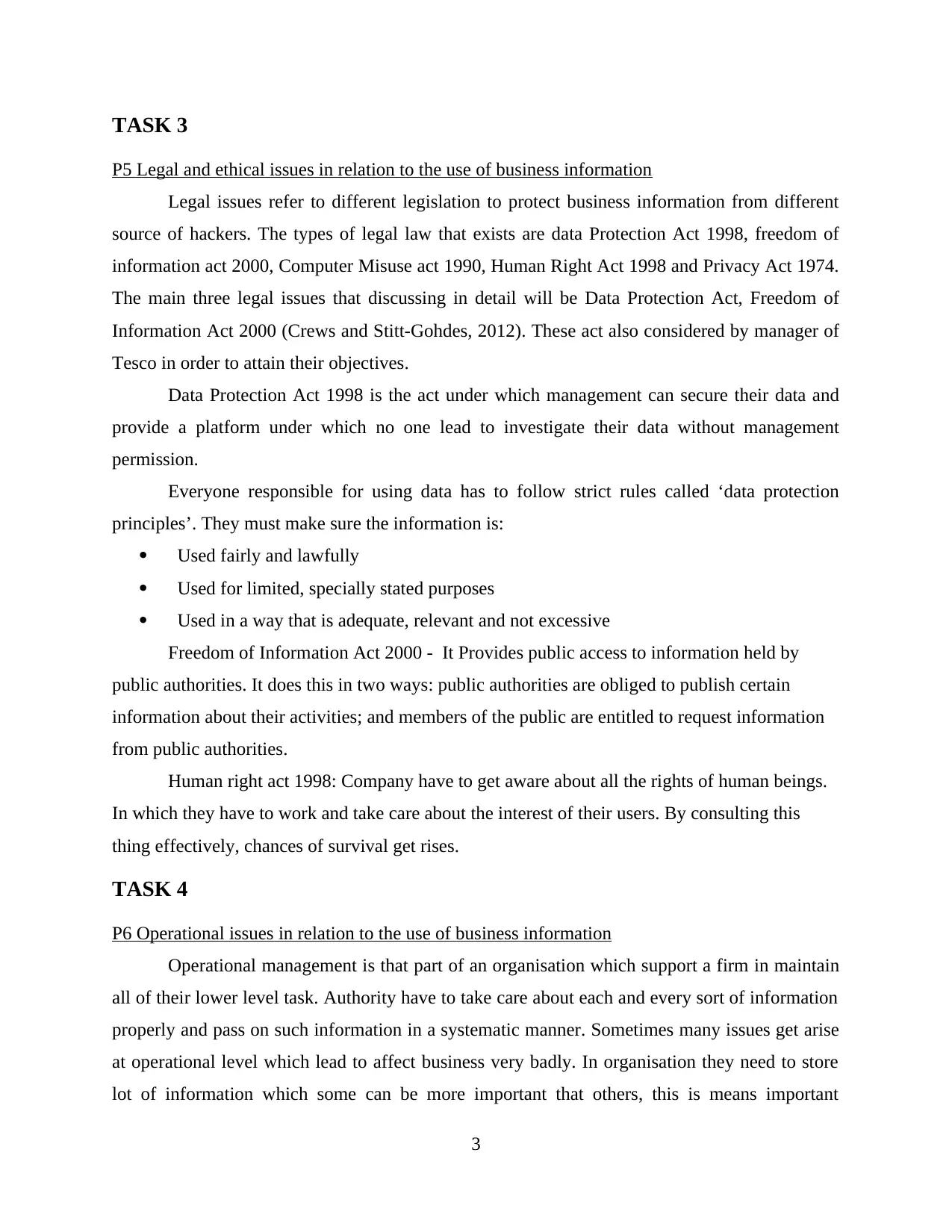
TASK 3
P5 Legal and ethical issues in relation to the use of business information
Legal issues refer to different legislation to protect business information from different
source of hackers. The types of legal law that exists are data Protection Act 1998, freedom of
information act 2000, Computer Misuse act 1990, Human Right Act 1998 and Privacy Act 1974.
The main three legal issues that discussing in detail will be Data Protection Act, Freedom of
Information Act 2000 (Crews and Stitt-Gohdes, 2012). These act also considered by manager of
Tesco in order to attain their objectives.
Data Protection Act 1998 is the act under which management can secure their data and
provide a platform under which no one lead to investigate their data without management
permission.
Everyone responsible for using data has to follow strict rules called ‘data protection
principles’. They must make sure the information is:
Used fairly and lawfully
Used for limited, specially stated purposes
Used in a way that is adequate, relevant and not excessive
Freedom of Information Act 2000 - It Provides public access to information held by
public authorities. It does this in two ways: public authorities are obliged to publish certain
information about their activities; and members of the public are entitled to request information
from public authorities.
Human right act 1998: Company have to get aware about all the rights of human beings.
In which they have to work and take care about the interest of their users. By consulting this
thing effectively, chances of survival get rises.
TASK 4
P6 Operational issues in relation to the use of business information
Operational management is that part of an organisation which support a firm in maintain
all of their lower level task. Authority have to take care about each and every sort of information
properly and pass on such information in a systematic manner. Sometimes many issues get arise
at operational level which lead to affect business very badly. In organisation they need to store
lot of information which some can be more important that others, this is means important
3
P5 Legal and ethical issues in relation to the use of business information
Legal issues refer to different legislation to protect business information from different
source of hackers. The types of legal law that exists are data Protection Act 1998, freedom of
information act 2000, Computer Misuse act 1990, Human Right Act 1998 and Privacy Act 1974.
The main three legal issues that discussing in detail will be Data Protection Act, Freedom of
Information Act 2000 (Crews and Stitt-Gohdes, 2012). These act also considered by manager of
Tesco in order to attain their objectives.
Data Protection Act 1998 is the act under which management can secure their data and
provide a platform under which no one lead to investigate their data without management
permission.
Everyone responsible for using data has to follow strict rules called ‘data protection
principles’. They must make sure the information is:
Used fairly and lawfully
Used for limited, specially stated purposes
Used in a way that is adequate, relevant and not excessive
Freedom of Information Act 2000 - It Provides public access to information held by
public authorities. It does this in two ways: public authorities are obliged to publish certain
information about their activities; and members of the public are entitled to request information
from public authorities.
Human right act 1998: Company have to get aware about all the rights of human beings.
In which they have to work and take care about the interest of their users. By consulting this
thing effectively, chances of survival get rises.
TASK 4
P6 Operational issues in relation to the use of business information
Operational management is that part of an organisation which support a firm in maintain
all of their lower level task. Authority have to take care about each and every sort of information
properly and pass on such information in a systematic manner. Sometimes many issues get arise
at operational level which lead to affect business very badly. In organisation they need to store
lot of information which some can be more important that others, this is means important
3
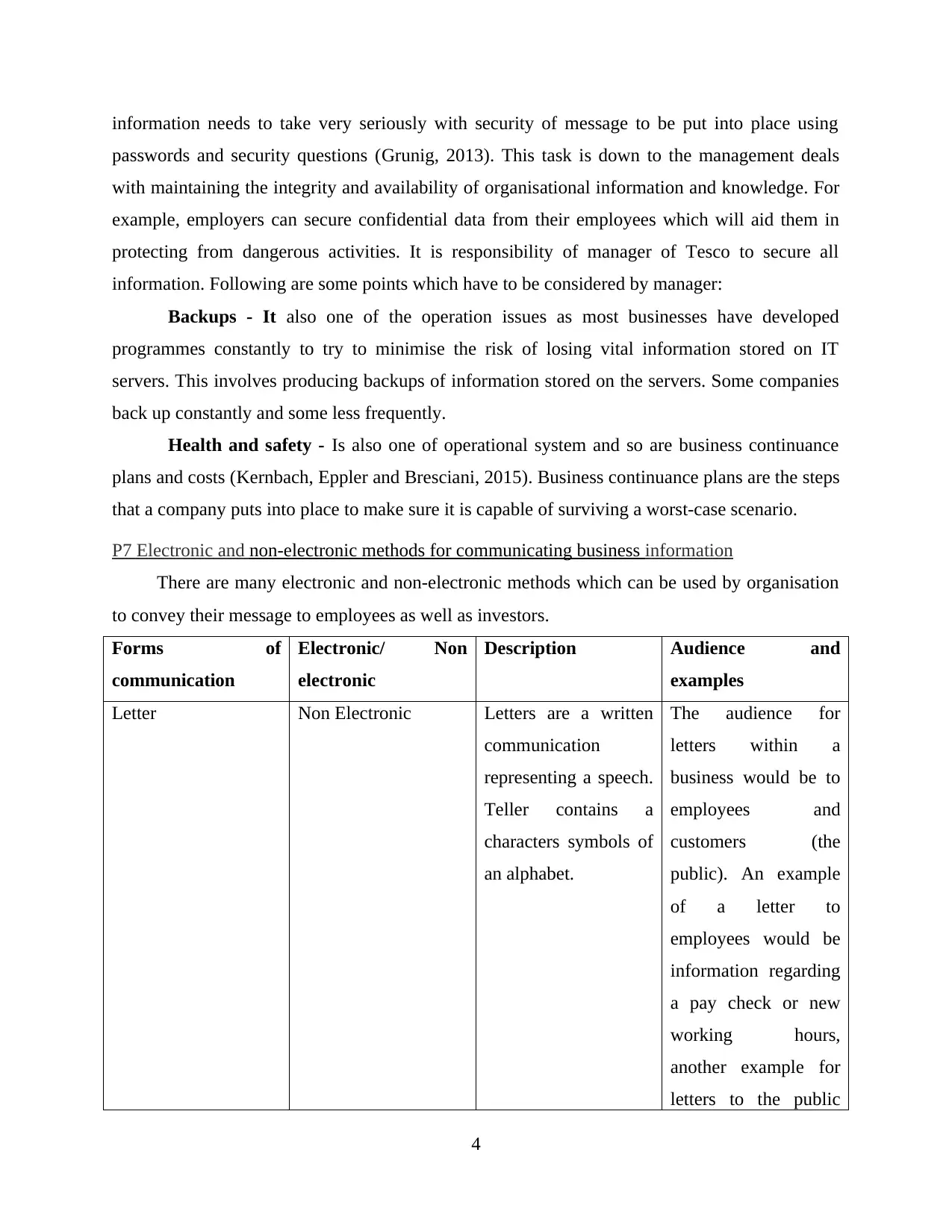
information needs to take very seriously with security of message to be put into place using
passwords and security questions (Grunig, 2013). This task is down to the management deals
with maintaining the integrity and availability of organisational information and knowledge. For
example, employers can secure confidential data from their employees which will aid them in
protecting from dangerous activities. It is responsibility of manager of Tesco to secure all
information. Following are some points which have to be considered by manager:
Backups - It also one of the operation issues as most businesses have developed
programmes constantly to try to minimise the risk of losing vital information stored on IT
servers. This involves producing backups of information stored on the servers. Some companies
back up constantly and some less frequently.
Health and safety - Is also one of operational system and so are business continuance
plans and costs (Kernbach, Eppler and Bresciani, 2015). Business continuance plans are the steps
that a company puts into place to make sure it is capable of surviving a worst-case scenario.
P7 Electronic and non-electronic methods for communicating business information
There are many electronic and non-electronic methods which can be used by organisation
to convey their message to employees as well as investors.
Forms of
communication
Electronic/ Non
electronic
Description Audience and
examples
Letter Non Electronic Letters are a written
communication
representing a speech.
Teller contains a
characters symbols of
an alphabet.
The audience for
letters within a
business would be to
employees and
customers (the
public). An example
of a letter to
employees would be
information regarding
a pay check or new
working hours,
another example for
letters to the public
4
passwords and security questions (Grunig, 2013). This task is down to the management deals
with maintaining the integrity and availability of organisational information and knowledge. For
example, employers can secure confidential data from their employees which will aid them in
protecting from dangerous activities. It is responsibility of manager of Tesco to secure all
information. Following are some points which have to be considered by manager:
Backups - It also one of the operation issues as most businesses have developed
programmes constantly to try to minimise the risk of losing vital information stored on IT
servers. This involves producing backups of information stored on the servers. Some companies
back up constantly and some less frequently.
Health and safety - Is also one of operational system and so are business continuance
plans and costs (Kernbach, Eppler and Bresciani, 2015). Business continuance plans are the steps
that a company puts into place to make sure it is capable of surviving a worst-case scenario.
P7 Electronic and non-electronic methods for communicating business information
There are many electronic and non-electronic methods which can be used by organisation
to convey their message to employees as well as investors.
Forms of
communication
Electronic/ Non
electronic
Description Audience and
examples
Letter Non Electronic Letters are a written
communication
representing a speech.
Teller contains a
characters symbols of
an alphabet.
The audience for
letters within a
business would be to
employees and
customers (the
public). An example
of a letter to
employees would be
information regarding
a pay check or new
working hours,
another example for
letters to the public
4
⊘ This is a preview!⊘
Do you want full access?
Subscribe today to unlock all pages.

Trusted by 1+ million students worldwide
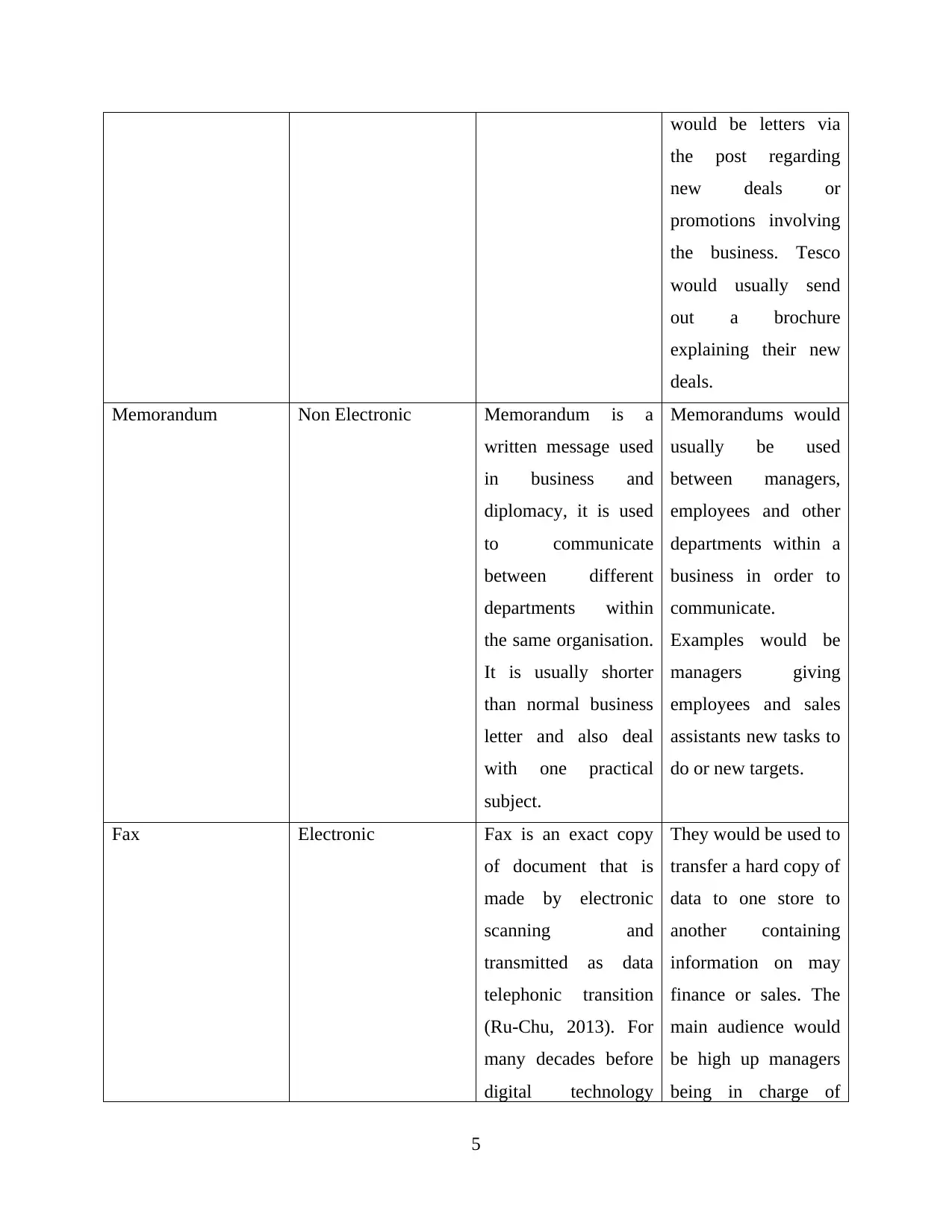
would be letters via
the post regarding
new deals or
promotions involving
the business. Tesco
would usually send
out a brochure
explaining their new
deals.
Memorandum Non Electronic Memorandum is a
written message used
in business and
diplomacy, it is used
to communicate
between different
departments within
the same organisation.
It is usually shorter
than normal business
letter and also deal
with one practical
subject.
Memorandums would
usually be used
between managers,
employees and other
departments within a
business in order to
communicate.
Examples would be
managers giving
employees and sales
assistants new tasks to
do or new targets.
Fax Electronic Fax is an exact copy
of document that is
made by electronic
scanning and
transmitted as data
telephonic transition
(Ru-Chu, 2013). For
many decades before
digital technology
They would be used to
transfer a hard copy of
data to one store to
another containing
information on may
finance or sales. The
main audience would
be high up managers
being in charge of
5
the post regarding
new deals or
promotions involving
the business. Tesco
would usually send
out a brochure
explaining their new
deals.
Memorandum Non Electronic Memorandum is a
written message used
in business and
diplomacy, it is used
to communicate
between different
departments within
the same organisation.
It is usually shorter
than normal business
letter and also deal
with one practical
subject.
Memorandums would
usually be used
between managers,
employees and other
departments within a
business in order to
communicate.
Examples would be
managers giving
employees and sales
assistants new tasks to
do or new targets.
Fax Electronic Fax is an exact copy
of document that is
made by electronic
scanning and
transmitted as data
telephonic transition
(Ru-Chu, 2013). For
many decades before
digital technology
They would be used to
transfer a hard copy of
data to one store to
another containing
information on may
finance or sales. The
main audience would
be high up managers
being in charge of
5
Paraphrase This Document
Need a fresh take? Get an instant paraphrase of this document with our AI Paraphraser
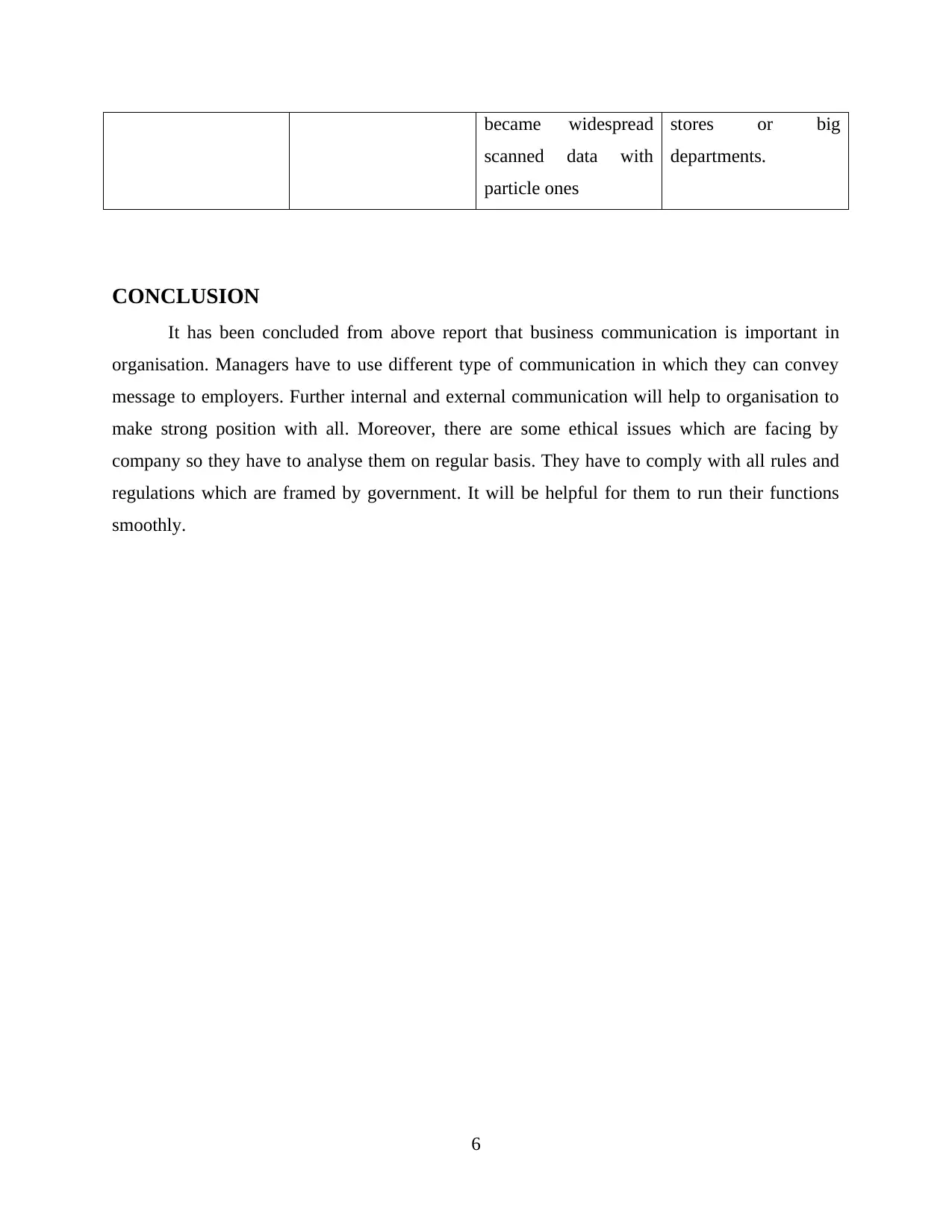
became widespread
scanned data with
particle ones
stores or big
departments.
CONCLUSION
It has been concluded from above report that business communication is important in
organisation. Managers have to use different type of communication in which they can convey
message to employers. Further internal and external communication will help to organisation to
make strong position with all. Moreover, there are some ethical issues which are facing by
company so they have to analyse them on regular basis. They have to comply with all rules and
regulations which are framed by government. It will be helpful for them to run their functions
smoothly.
6
scanned data with
particle ones
stores or big
departments.
CONCLUSION
It has been concluded from above report that business communication is important in
organisation. Managers have to use different type of communication in which they can convey
message to employers. Further internal and external communication will help to organisation to
make strong position with all. Moreover, there are some ethical issues which are facing by
company so they have to analyse them on regular basis. They have to comply with all rules and
regulations which are framed by government. It will be helpful for them to run their functions
smoothly.
6
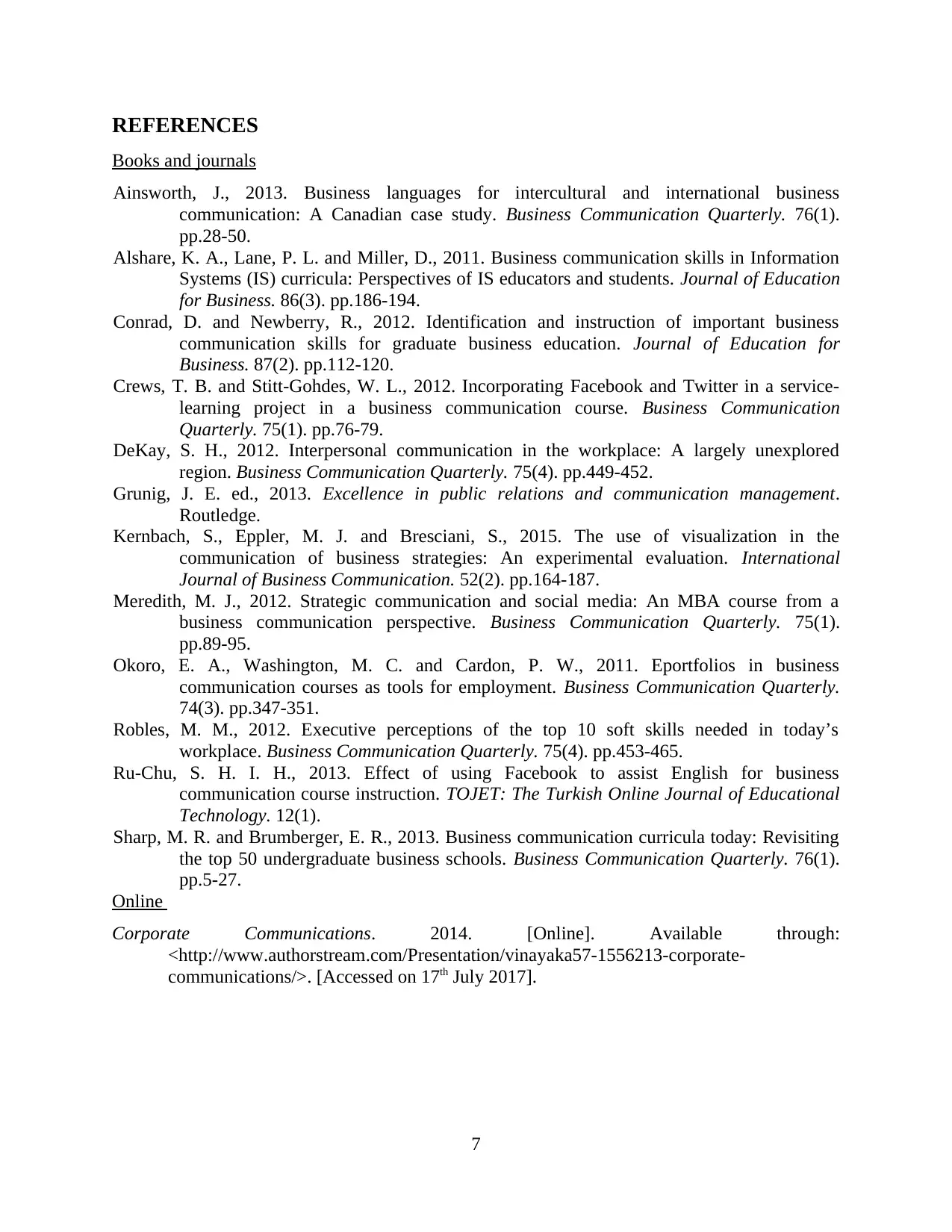
REFERENCES
Books and journals
Ainsworth, J., 2013. Business languages for intercultural and international business
communication: A Canadian case study. Business Communication Quarterly. 76(1).
pp.28-50.
Alshare, K. A., Lane, P. L. and Miller, D., 2011. Business communication skills in Information
Systems (IS) curricula: Perspectives of IS educators and students. Journal of Education
for Business. 86(3). pp.186-194.
Conrad, D. and Newberry, R., 2012. Identification and instruction of important business
communication skills for graduate business education. Journal of Education for
Business. 87(2). pp.112-120.
Crews, T. B. and Stitt-Gohdes, W. L., 2012. Incorporating Facebook and Twitter in a service-
learning project in a business communication course. Business Communication
Quarterly. 75(1). pp.76-79.
DeKay, S. H., 2012. Interpersonal communication in the workplace: A largely unexplored
region. Business Communication Quarterly. 75(4). pp.449-452.
Grunig, J. E. ed., 2013. Excellence in public relations and communication management.
Routledge.
Kernbach, S., Eppler, M. J. and Bresciani, S., 2015. The use of visualization in the
communication of business strategies: An experimental evaluation. International
Journal of Business Communication. 52(2). pp.164-187.
Meredith, M. J., 2012. Strategic communication and social media: An MBA course from a
business communication perspective. Business Communication Quarterly. 75(1).
pp.89-95.
Okoro, E. A., Washington, M. C. and Cardon, P. W., 2011. Eportfolios in business
communication courses as tools for employment. Business Communication Quarterly.
74(3). pp.347-351.
Robles, M. M., 2012. Executive perceptions of the top 10 soft skills needed in today’s
workplace. Business Communication Quarterly. 75(4). pp.453-465.
Ru-Chu, S. H. I. H., 2013. Effect of using Facebook to assist English for business
communication course instruction. TOJET: The Turkish Online Journal of Educational
Technology. 12(1).
Sharp, M. R. and Brumberger, E. R., 2013. Business communication curricula today: Revisiting
the top 50 undergraduate business schools. Business Communication Quarterly. 76(1).
pp.5-27.
Online
Corporate Communications. 2014. [Online]. Available through:
<http://www.authorstream.com/Presentation/vinayaka57-1556213-corporate-
communications/>. [Accessed on 17th July 2017].
7
Books and journals
Ainsworth, J., 2013. Business languages for intercultural and international business
communication: A Canadian case study. Business Communication Quarterly. 76(1).
pp.28-50.
Alshare, K. A., Lane, P. L. and Miller, D., 2011. Business communication skills in Information
Systems (IS) curricula: Perspectives of IS educators and students. Journal of Education
for Business. 86(3). pp.186-194.
Conrad, D. and Newberry, R., 2012. Identification and instruction of important business
communication skills for graduate business education. Journal of Education for
Business. 87(2). pp.112-120.
Crews, T. B. and Stitt-Gohdes, W. L., 2012. Incorporating Facebook and Twitter in a service-
learning project in a business communication course. Business Communication
Quarterly. 75(1). pp.76-79.
DeKay, S. H., 2012. Interpersonal communication in the workplace: A largely unexplored
region. Business Communication Quarterly. 75(4). pp.449-452.
Grunig, J. E. ed., 2013. Excellence in public relations and communication management.
Routledge.
Kernbach, S., Eppler, M. J. and Bresciani, S., 2015. The use of visualization in the
communication of business strategies: An experimental evaluation. International
Journal of Business Communication. 52(2). pp.164-187.
Meredith, M. J., 2012. Strategic communication and social media: An MBA course from a
business communication perspective. Business Communication Quarterly. 75(1).
pp.89-95.
Okoro, E. A., Washington, M. C. and Cardon, P. W., 2011. Eportfolios in business
communication courses as tools for employment. Business Communication Quarterly.
74(3). pp.347-351.
Robles, M. M., 2012. Executive perceptions of the top 10 soft skills needed in today’s
workplace. Business Communication Quarterly. 75(4). pp.453-465.
Ru-Chu, S. H. I. H., 2013. Effect of using Facebook to assist English for business
communication course instruction. TOJET: The Turkish Online Journal of Educational
Technology. 12(1).
Sharp, M. R. and Brumberger, E. R., 2013. Business communication curricula today: Revisiting
the top 50 undergraduate business schools. Business Communication Quarterly. 76(1).
pp.5-27.
Online
Corporate Communications. 2014. [Online]. Available through:
<http://www.authorstream.com/Presentation/vinayaka57-1556213-corporate-
communications/>. [Accessed on 17th July 2017].
7
⊘ This is a preview!⊘
Do you want full access?
Subscribe today to unlock all pages.

Trusted by 1+ million students worldwide

8
1 out of 10
Related Documents
Your All-in-One AI-Powered Toolkit for Academic Success.
+13062052269
info@desklib.com
Available 24*7 on WhatsApp / Email
![[object Object]](/_next/static/media/star-bottom.7253800d.svg)
Unlock your academic potential
Copyright © 2020–2025 A2Z Services. All Rights Reserved. Developed and managed by ZUCOL.





